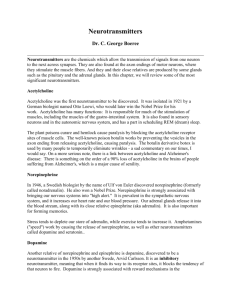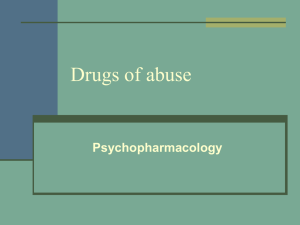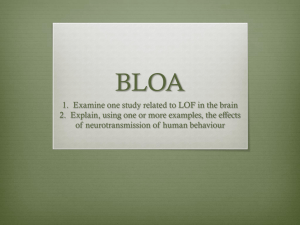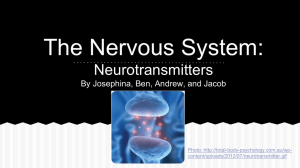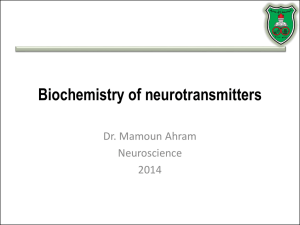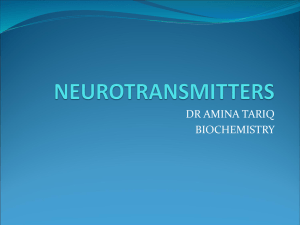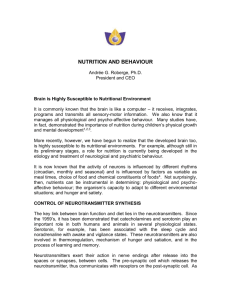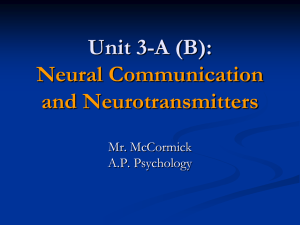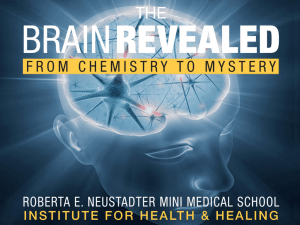Mood & Nuerotransmitters - Center for Optimal Health
advertisement
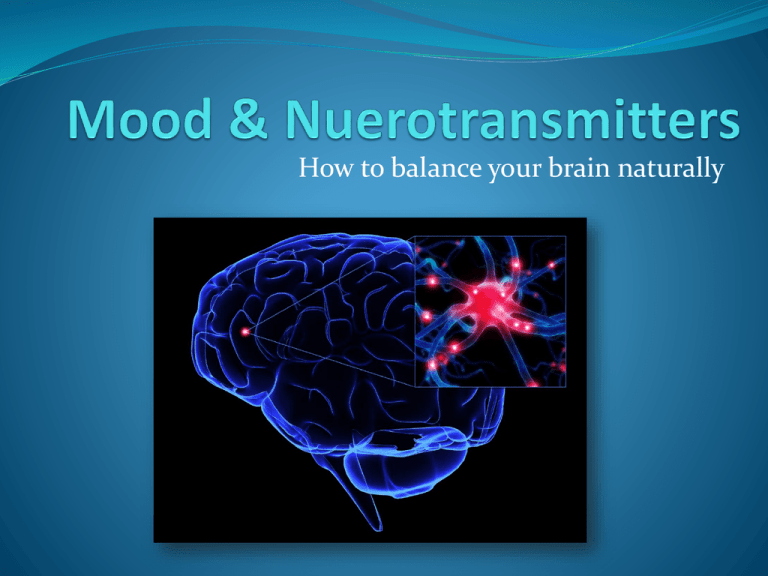
How to balance your brain naturally Neurotransmitters are chemical messengers that help relay information throughout the body. They transmit information through nerve cells called neurons. In its most basic form a neuron has two ends (although either can have multiple branches): an axon and a dendrite. A neuron communicates with other neurons by sending neurotransmitters from its axon to a dendrite of another neuron. The space between the axon and the dendrite is called a synapse; this is the space across which a neurotransmitter must cross. Signal Messengers Neurotransmitters are stored in in little packages called synaptic vesicles. They are released if an appropriate charge is sent down the axon. They cross the synapse to dock with receptors on the dendrite of another neuron If enough neurotransmitters dock with the receptors, a signal is sent down that neuron and the message continues on. If not enough neurotransmitter docks with the receptor, then the message stops. Electric Communication Electricity going through a wire. Turning up the voltage will cause more electricity to go through the wire. The NTs act like electricity – if we have enough electricity, the lights will come on and things will run smoothly. If we don’t have enough electricity, things just don’t work like they should. Once the neurotransmitter is released from the receptor, it is either taken back up into the synaptic vesicle of the axon by a neurotransmitter reuptake pump/transporter or it is destroyed by enzymes that are present in the synapse. If the neurotransmitters are taken back up into the pre-synaptic neuron via the reuptake transporters, they are protected and can be used again. If the transporters are blocked (SSRIs), the neurotransmitters are eventually destroyed and cleared from the system by enzymes. Bundles of neurons run from your brain to every organ and system in your body. NTs help to control and regulate most of your body’s functions including: Mood Memory Heart rate Hunger Cravings Pain sensation/tolerance Breathing Hormone balance Sleep Focus Body temperature Learning Binging Digestion Coordination Concentration Pleasure Arousal Addiction Breathing Blood pressure Weight Kidney function Behavior 2 Basic Types • Most neurotransmitters are classified in one of two types – inhibitory and excitatory. • Inhibitory neurotransmitters slow down the flow of information by calming and reducing the activity of neurons; they help to bring balance to the body. • Excitatory neurotransmitters generally increase the flow of information. • It is the balance between the inhibitory and excitatory neurotransmitters that has the greatest effect on your body functions. Inhibitory There are several inhibitory neurotransmitters in the body, but the two that are thought to have the greatest and widest reaching effects are serotonin and GABA (gamma amino butyric acid). Serotonin Most people know of serotonin in relation to mood and a class of drugs known as selective serotonin reuptake inhibitors (SSRIs). Most people do not know that most of the serotonin in the body is produced and found in the intestine (approximately 90%) and the remainder is mostly found in the brain and central nervous system. Serotonin helps to regulate appetite, sleep, memory, learning, temperature, mood, behavior, muscle contraction, cardiovascular function and hormone balance. GABA GABA is an inhibitory neurotransmitter that helps with reducing anxiety calming the mind and releasing tension. Some anti-anxiety medications like benzodiazepines and barbiturates as well as many sleep medications work primarily by increasing the amount of GABA released in a neuron. Excitatory The main excitatory neurotransmitters in the body are: Dopamine Norepinephrine Epinephrine Glutamate Dopamine Dopamine plays a number of important functions in the brain. Reward system whereby we feel pleasure, achieve heightened arousal and do much of our learning. Every type of reward that has been studied increases the level of dopamine transmission in the brain. Highly addictive drugs, including cocaine and amphetamines (i.e., methamphetamine, “speed”, Adderall, Vyvanse, Dexedrine) act directly on the dopamine system. Dopamine also helps with focus, concentration and memory as well as motivation. Several important diseases are associated with dysfunctions in the dopamine system, including Parkinson’s disease, schizophrenia, restless leg syndrome and ADD/ADHD. Norepinephrine Norepinephrine is made from dopamine. This & epinephrine are responsible for the “fight-or-flight” response to stress, which increases your heart-rate, increases blood sugar and increases blood flow to the muscles to allow you to act or react to stressors. Norepinephrine also affects blood pressure and heart rate, although it’s most widely known impact is on alertness, arousal, decision making, attention and focus. Several ADHD medications, such as (Ritalin/Concerta), amphetamines (Adderall, Dexedrine) and are used to increase norepinephrine levels in the brain in an attempt to help improve focus and concentration. Other classes of drugs seek to modulate norepinephrine in the brain to improve depression, including venlafaxine (Effexor), duloxetine (Cymbalta) and bupropion (Wellbutrin). Epinephrine Epinephrine (also known as adrenaline) is released in reaction to stress and is partially responsible for the “fight-or-flight” response. It affects a number of important functions, including heart rate, breathing and blood pressure. Imbalances in epinephrine can lead to “adrenaline junkies”, a term that is often used to describe people that seem to enjoy stress and stressful activities. They also usually suffer from constant need for urgency, have trouble relaxing or sleeping and keep ‘the pedal to the medal’ as they race through life. Glutamate Glutamate is the most abundant excitatory neurotransmitter in the human brain. It plays key roles in cognitive functions like learning and memory. Imbalances in glutamate levels are associated with Alzheimer’s disease, seizures and forms of autism. Glutamate is also used as a flavor enhancer in the form of monosodium glutamate (MSG). How Are Neurotransmitters Made? Catecholamines Dopamine, norepinephrine and epinephrine, collective known as the ‘catecholamines’ are key excitatory neurotransmitters. These control most of the other systems and functions in the body. Cortisol synthesis, hormone synthesis and the sympathetic nervous system are all controlled by norepinephrine; mood, body temperature and sleep are regulated by serotonin and norepinephrine; and focus, concentration, memory and fine-motor skills are controlled by dopamine. Anxiety Neurotransmitter systems are partially controlled by the serotonin-catecholamine systems. GABA-glutamate neurotransmitter system is associated with control of anxiety and panic attacks. Rx to treat anxiety and/or panic attacks work on GABA receptors; these drugs include lorazepam (Ativan), clonazepam (Klonopin), diazepam (Valium) and alprazolam (Xanax). These drugs may help reduce the feeling of anxiety in the short-term, but do not provide lasting relief and can lead to dependence and withdrawal reactions. Long Term Relief Serotonin and catecholamine neurotransmitter levels are brought to proper levels, anxiety and panic attacks usually resolve. This indicates control of the GABA-glutamate system by the serotonin-catecholamine system How? Amino Acid Therapy Best amino acids to control symptoms of anxiety are not GABA or glutamate as they work with the secondary system. 5-HTP (or L-tryptophan) and L-tyrosine Influence the primary serotonin-catecholamine system. Restores proper functioning by getting to the root cause and provides a long-term solution. Competition If you take only 5-HTP or L-tyrosine they will compete with and inhibit the synthesis of the opposite precursor because they compete for this enzyme. This means that if you take only 5-HTP (to increase serotonin) or only L-dopa or L-tyrosine (to increase dopamine levels) you will decrease the synthesis of the other neurotransmitter . This will lead to or increase the neurotransmitter imbalances present. Imbalance Symptoms When imbalances in neurotransmitters occur, information is not relayed optimally in the brain which causes symptoms. Depression Insomnia Low pain tolerance PMS Weight gain Anxiety Cravings Hot flashes Sleep difficulties Poor weight loss Migraines Increased appetite Mood swings Poor memory Hormone imbalances Poor mental focus Poor concentration Restless legs Fibromyalgia Fatigue/Chronic Poor thyroid fatigue function Parkinson’s Disease ADD/ADHD Trichotillomania Addictions Binging behavior Eating disorders Obsessive thoughts Compulsion Crohn’s disease What Causes Imbalance? Genetics Stress Toxic burden Head or neck trauma Nutritional deficiency Digestive imbalances Sleep disturbances Alcohol use Chronic pain Food hypersensitivities Illicit drug use Medication use, including antidepressants, anti-anxiety, sleep and migraine medications Bringing Back Balance Turn up the Voltage As we discussed earlier, the only way to increase neurotransmitter levels in the brain is to take amino acids (along with the necessary cofactors) which can cross the blood brain barrier where they can then be made into neurotransmitters. Increasing neurotransmitter levels through the neurons is analogous to increasing the voltage in an electrical wire, where by turning up the voltage you get more electricity out the other end of the wire. Overcoming Nerve Damage Even if 50% of the neurons in a nerve bundle are damaged or destroyed, if we give the remaining neurons more amino acids (in the right dosages), the remaining healthy neurons will manufacture more neurotransmitters, effectively alleviating symptoms and restoring normal function. Why diet isn’t enough.. Diet alone can’t make up for specific neurotransmitter imbalances because the uptake of amino acids by the body is not selective. Foods contain an array of amino acids and no food contains just the precursors needed to specifically affect only serotonin and/or dopamine. When you eat food, your body takes up many different amino acids at random, making it impossible to target just the neurotransmitters we are trying to affect. Precursors Amino acid precursors of serotonin and dopamine have two primary applications. Keep drugs that work with neurotransmitters from depleting NTs This is the situation when someone is taking a reuptake inhibitor that ‘stops working’. When we provide such a person with balanced amino acid therapy, we give the body what it needs to make the necessary neurotransmitters, which increases neurotransmitter levels. Enhance your Rx’s Drugs that work by shuffling around neurotransmitters (such as SSRI, SNRI and other medications) have more neurotransmitter to work with under this scenario so they can appear to start ‘working’ again. Continue to use the medication without fear of further neurotransmitter depletion due to the drug. Amino acid therapy helps the drug do its job more effectively and efficiently. Finding Balance Naturally Proper use of amino acids can also serve as a stand-alone method to manage disorders related to neurotransmitter imbalance. Most disorders are not due to a drug deficiency; they are due to a nutrient deficiency or improper neurotransmitter function. By supplying the body the nutrients it needs to produce the correct balance of NTs, we can often restore proper function. AA therapy can provide a viable option to restore optimal NT function, eliminating symptoms without the need for medication. Co-Factors Needed Tyrosine 5-HTP Cysteine Cofactors needed for neurotransmitter synthesis Vitamin C Vitamin B6 Calcium Selenium Folic acid/Folate How to test? Test the Precursors: Tyrosine, Tryptophan, Glutamic Acid Look at the NT’s breakdown products in urine Assess Vitamin Status, B, C, Selenium, Folic Acid Most people exhibit more than one of these conditions but fail to make the connection between them. This connection is not made because most health care professionals don’t know much about brain chemistry or how to use amino acid therapy to correct the underlying neurotransmitter imbalances. Hormonal Imbalance Hormones represent another class of chemical messengers. Balancing the serotonin-catecholamine system as a first course of action (serotonin and dopamine) symptoms associated with hormone imbalance (e.g., hot flashes, mood swings, irregular menses) often resolve or are reduced. Take home note…. The important thing is to keep looking upstream to find the root imbalance so we can achieve a lasting solution.

